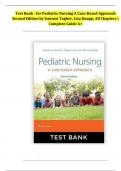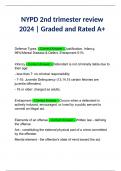Test Bank - for Pediatric Nursing A Case-Based Approach
Second Edition by Gannon Tagher, Lisa Knapp, All Chapters |
Complete Guide A+
, Test Bank: Pediatric Nursing-A Case-Based Approach 2nd Edition Tagher
f f f f f f f
f
f
Knapp
f
Chapter f1: f Bronchiolitis
1. Which fintervention fis fappropriate ffor fthe finfant fhospitalized fwith fbronchiolitis?
a. Position fon fthe fside fwith fneck fslightly fflexed.
b. Administer fantibiotics fas fordered.
c. Restrict foral fand fparenteral ffluids fif ftachypneic.
d. Give fcool, fhumidified foxygen.
fANS: fD
Cool, fhumidified foxygen fis fgiven fto frelieve fdyspnea, fhypoxemia, fand finsensible ffluid floss ffrom
tachypnea. fThe finfant fshould fbe fpositioned fwith fthe fhead fand fchest felevated fat fa f30- fto f40-degree
fangle fand fthe fneck fslightly fextended fto fmaintain fan fopen fairway fand fdecrease fpressure fon fthe
fdiaphragm. f The fetiology fof fbronchiolitis f is fviral. fAntibiotics f are fgiven fonly fif f there fis fa
fsecondary fbacterial finfection. fTachypnea fincreases finsensible ffluid floss. fIf fthe finfant fis
ftachypneic, ffluids fare fgiven fparenterally fto fprevent fdehydration.
2. An finfant fwith fbronchiolitis fis fhospitalized. fThe fcausative forganism fis frespiratory fsyncytial
fvirus f(RSV). fThe fnurse fknows fthat fa fchild finfected fwith fthis fvirus frequires fwhat ftype fof
isolation?
a. Reverse fisolation
b. Airborne fisolation
c. Contact fPrecautions
d. Standard fPrecautions
fANS: fC
RSV fis ftransmitted fthrough fdroplets. fIn faddition fto fStandard fPrecautions fand fhand fwashing,
Contact fPrecautions fare frequired. fCaregivers fmust fuse fgloves fand fgowns fwhen fentering fthe
froom. fCare fis ftaken fnot fto ftouch ftheir fown feyes for fmucous fmembranes fwith fa fcontaminated
fgloved fhand. fChildren fare fplaced fin fa fprivate froom for fin fa froom fwith fother fchildren fwith fRSV
finfections. fReverse fisolation ffocuses fon fkeeping fbacteria faway ffrom fthe finfant. fWith fRSV, fother
fchildren fneed fto fbe fprotected ffrom fexposure fto fthe fvirus. fThe fvirus fis fnot fairborne.
3. A fchild fhas fa fchronic fcough fand fdiffuse fwheezing fduring fthe fexpiratory fphase fof frespiration.
This fsuggests fwhat fcondition?
a. Asthma
b. Pneumonia
c. Bronchiolitis
d. Foreign fbody fin ftrachea
fANS: fA
Asthma fmay fhave fthese fchronic fsigns fand fsymptoms. fPneumonia fappears fwith fan facute fonset,
fever, fand fgeneral fmalaise. fBronchiolitis fis fan facute fcondition fcaused fby frespiratory fsyncytial
,virus. fForeign fbody fin fthe ftrachea foccurs fwith facute frespiratory fdistress for ffailure fand fmaybe
fstridor.
4. Which fnursing fdiagnosis fis fmost fappropriate ffor fan finfant fwith facute fbronchiolitis fdue fto
frespiratory fsyncytial fvirus f(RSV)?
a. Activity fIntolerance
b. Decreased fCardiac fOutput
c. Pain, fAcute
d. Tissue fPerfusion, fIneffective f(peripheral)
fANS. fA
Rationale f1: fActivity fintolerance fis fa fproblem fbecause fof fthe fimbalance fbetween foxygen fsupply
fand fdemand. fCardiac foutput fis fnot fcompromised fduring fan facute fphase fof fbronchiolitis. fPain fis
fnot fusually fassociated fwith facute fbronchiolitis. fTissue fperfusion f(peripheral) fis fnot faffected fby
fthis frespiratory-disease fprocess.
Rationale f2: fActivity fintolerance fis fa fproblem fbecause fof fthe fimbalance fbetween foxygen fsupply
fand fdemand. fCardiac foutput fis fnot fcompromised fduring fan facute fphase fof fbronchiolitis. fPain fis
fnot fusually fassociated fwith facute fbronchiolitis. fTissue fperfusion f(peripheral) fis fnot faffected fby
fthis frespiratory-disease fprocess.
Rationale f3: fActivity fintolerance fis fa fproblem fbecause fof fthe fimbalance fbetween foxygen fsupply
fand fdemand. fCardiac foutput fis fnot fcompromised fduring fan facute fphase fof fbronchiolitis. fPain fis
fnot fusually fassociated fwith facute fbronchiolitis. fTissue fperfusion f(peripheral) fis fnot faffected fby
fthis frespiratory-disease fprocess.
Rationale f4: fActivity fintolerance fis fa fproblem fbecause fof fthe fimbalance fbetween foxygen fsupply
fand fdemand. fCardiac foutput fis fnot fcompromised fduring fan facute fphase fof fbronchiolitis. fPain fis
fnot fusually fassociated fwith facute fbronchiolitis. fTissue fperfusion f(peripheral) fis fnot faffected fby
fthis frespiratory-disease fprocess.
Global fRationale: fActivity fintolerance fis fa fproblem fbecause fof fthe fimbalance fbetween foxygen
fsupply fand fdemand. fCardiac foutput fis fnot fcompromised fduring fan facute fphase fof fbronchiolitis.
fPain fis fnot fusually fassociated fwith facute fbronchiolitis. fTissue fperfusion f(peripheral) fis fnot
faffected fby fthis frespiratory-disease fprocess.
Chapter f2: fAsthma
1. The fnurse fis fcaring ffor fa fchild fhospitalized ffor fstatus fasthmaticus. fWhich fassessment ffinding
fsuggests fthat fthe f childs fcondition f is fworsening?
a. Hypoventilation
b. Thirst
c. Bradycardia
d. Clubbing
fANS: fA
, The fnurse fwould fassess fthe fchild ffor fsigns fof fhypoxia, fincluding frestlessness, ffatigue, firritability,
fand fincreased fheart fand frespiratory frate. fAs fthe fchild ftires ffrom fthe fincreased fwork fof fbreathing
fhypoventilation foccurs fleading fto fincreased fcarbon fdioxide flevels. fThe fnurse fwould fbe falert ffor
fsigns fof fhypoxia. fThirst fwould freflect fthe fchilds fhydration fstatus. fBradycardia fis fnot fa fsign fof
fhypoxia; ftachycardia fis. fClubbing fdevelops fover fa fperiod fof fmonths fin fresponse fto fhypoxia. fThe
fpresence fof fclubbing fdoes fnot findicate fthe fchilds fcondition fis fworsening.
2. Which ffinding fis fexpected fwhen fassessing fa fchild fhospitalized ffor fasthma?
a. Inspiratory fstridor
b. Harsh, fbarky fcough
c. Wheezing
d. Rhinorrhea
fANS: fC
Wheezing fis fa fclassic fmanifestation fof fasthma. fInspiratory fstridor fis fa fclinical fmanifestation fof
croup. fA fharsh, fbarky fcough fis fcharacteristic fof fcroup. fRhinorrhea fis fnot fassociated fwith fasthma.
3. A fchild fhas fhad fcold fsymptoms ffor fmore fthan f2 fweeks, fa fheadache, fnasal fcongestion fwith
fpurulent fnasal fdrainage, ffacial ftenderness, fand fa fcough fthat fincreases fduring fsleep. fThe fnurse
frecognizes fthese fsymptoms fare fcharacteristic fof fwhich frespiratory fcondition?
a. Allergic frhinitis
b. Bronchitis
c. Asthma
d. Sinusitis
fANS: fD
Sinusitis fis fcharacterized fby fsigns fand fsymptoms fof fa fcold fthat fdo fnot fimprove fafter f14 fdays, fa
low-grade ffever, fnasal fcongestion fand fpurulent fnasal fdischarge, fheadache, ftenderness, fa ffeeling
fof ffullness fover fthe faffected fsinuses, fhalitosis, fand fa fcough fthat fincreases fwhen fthe fchild fis flying
fdown. fThe fclassic fsymptoms fof fallergic frhinitis fare fwatery frhinorrhea, fitchy fnose, feyes, fears, fand
fpalate, fand fsneezing. fSymptoms foccur fas flong fas fthe fchild fis fexposed fto fthe fallergen. fBronchitis
fis fcharacterized fby fa fgradual fonset fof frhinitis fand fa fcough fthat fis finitially fnonproductive fbut fmay
fchange fto fa floose fcough. fThe fmanifestations fof fasthma fmay fvary, fwith fwheezing fbeing fa fclassic
fsign. fThe fsymptoms fpresented fin fthe fquestion fdo fnot fsuggest fasthma.
4. What fis fa fcommon ftrigger ffor fasthma fattacks fin fchildren?
a. Febrile fepisodes
b. Dehydration
c. Exercise
d. Seizures
fANS: fC





